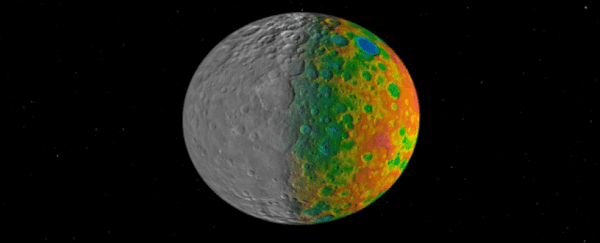Researchers from the US might finally know why Ceres – the dwarf planet inside our Solar System's asteroid belt – doesn't show any signs of large impact craters.
Which is weird, because they're geological features that – given the planet's 4.5-billion-year existence – should definitely be present.
The new findings suggest that the missing craters might have deteriorated over hundreds of millions of years thanks to Ceres' icy crust and geothermal activity churning just out of sight.
"We concluded that a significant population of large craters on Ceres has been obliterated beyond recognition over geological time scales, which is likely the result of Ceres' peculiar composition and internal evolution," said lead investigator Simone Marchi, from the Southwest Research Institute in Colorado.
Before looking for possible reasons why the large craters are missing on the surface of Ceres, the team used computer models to figure out just how many there should be.
They concluded that, over the course of the planet's lifetime, at least 10 to 15 large impact craters – meaning craters larger than 400 kilometres (250 miles) wide – and at least 40 mid-sized, 100-kilometre (60-mile) wide craters should mark the landscape.
These findings, though, do not add up to the amount of craters actually found on the surface of Ceres because – thanks to NASA's Dawn mission – researchers know that there are only 16 craters measuring larger than 100 kilometres (60 miles) in diameter and a whopping zero larger than 280 kilometres (175 miles).
The only sign of larger impacts are three 'planitiae' – large depressions – that might have been left over from some extremely large impacts long ago.
With that information gathered, the team went about discussing how Ceres might have escaped the fate they predicted in their models. They offer a few suggestions, though none are concrete conclusions by any means.
One of the best hypotheses is that Ceres actually formed further out in our Solar System where impacts were less likely. Then, over millions of years, the dwarf planet's orbit brought it closer, leaving it in the asteroid belt.
"The recent detection of widespread ammoniated phyllosilicates on Ceres has raised the possibility that Ceres could have been implanted in the main belt from the outer Solar System," the team said in the study.
"Thus, this poses the question of whether a late implantation of Ceres into the main belt's collisionally intense environment could explain the observed lack of large craters."
The other most likely reason behind the missing craters is that geothermal activity, coupled with the icy makeup of Ceres' crust, might have obliterated the larger craters over millions of years.
"The formation of a significant population of large craters, and their subsequent obliteration, is thus likely the result of Ceres' internal processes," the team explains.
"For instance, viscous relaxation of long-wavelength topography may obscure very old impact basins, although short wavelength features such as rims are projected to survive over geological timescales, in analogy to the icy satellites."
"This conclusion reveals that Ceres' cratering record is inextricably linked to its peculiar composition and internal evolution," they conclude.
The missing craters aren't the only geological mystery that researchers might have solved recently.
Earlier this month, NASA researchers found evidence that suggests the mysterious bright spots found inside Ceres' Occator Crater formed when impacts scraped away parts of the planet's surface, letting sodium carbonate – a type of salt found around hydrothermal vents – leak out.
Hopefully, as the researchers continue to study the dwarf planet, we will eventually know more about these missing craters and how Ceres' mysterious geological activity works on a detailed level.
The new findings were recently published in the journal Nature Communications.
